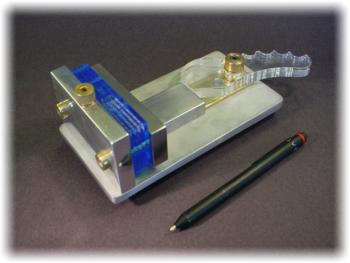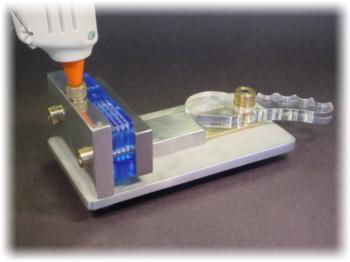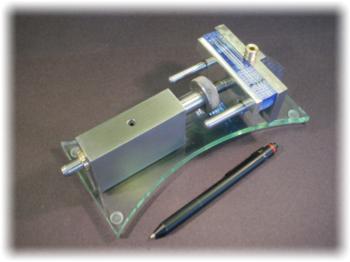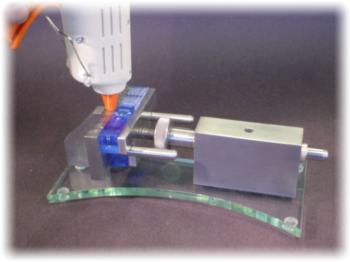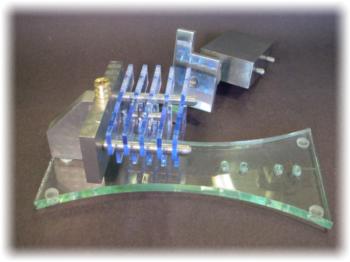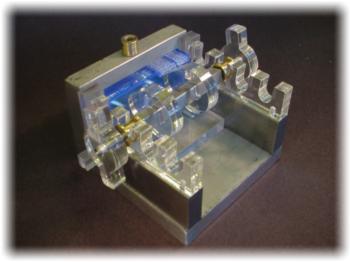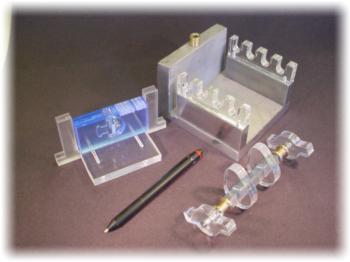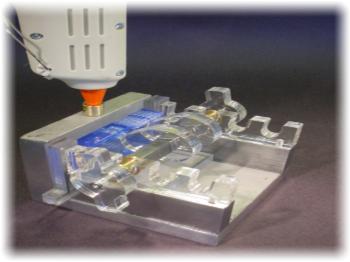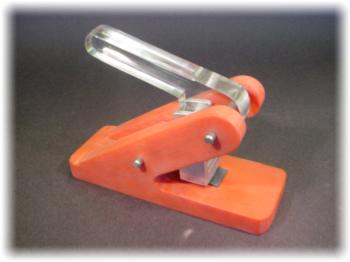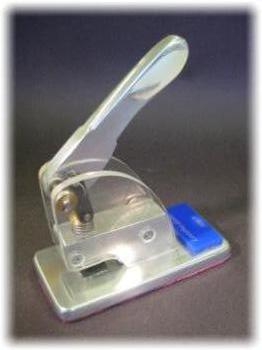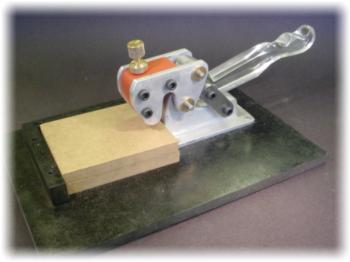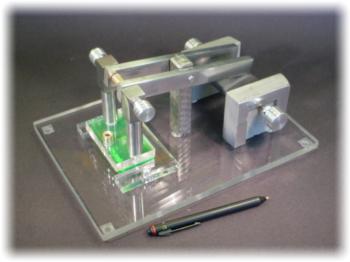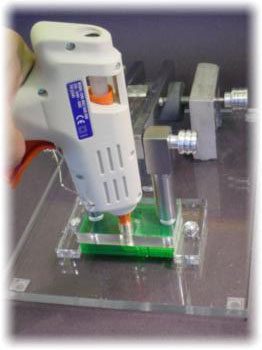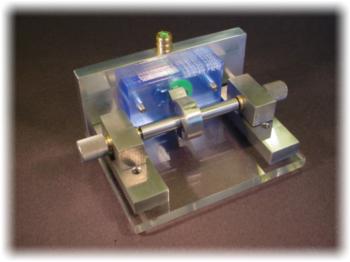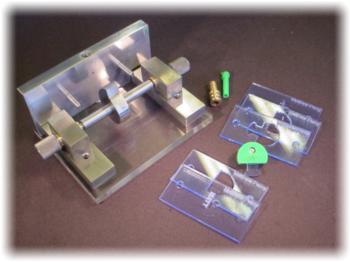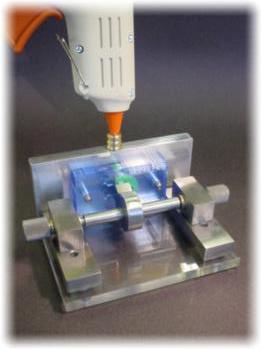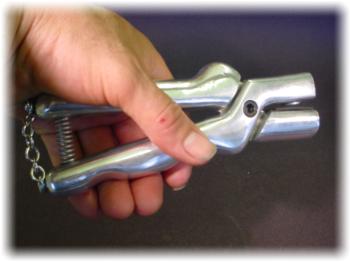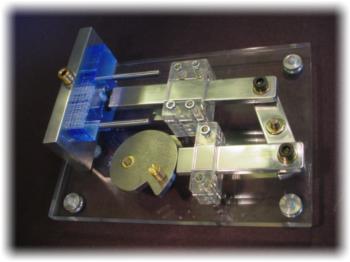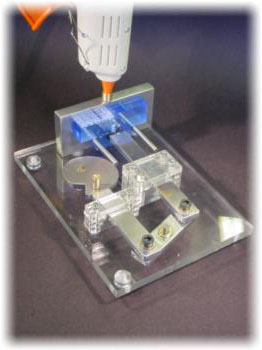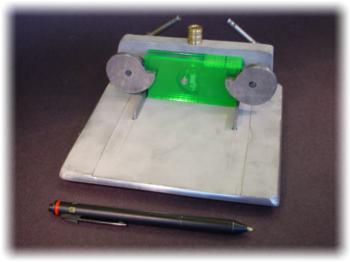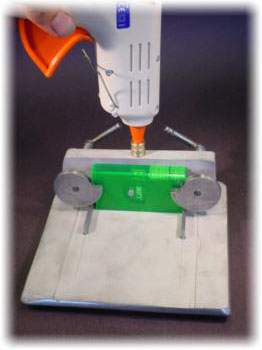|
 An
injection moulding tool by Alex. The cam handle is laser cut from 10mm
acrylic. The plates making up the die are laser cut from live edge acrylic
and are lined up using steel guide pins. The Brass parts have been turned using a CNC lathe. The aluminium plates have been milled manually using a horizontal mill and then hand finished to a satin finish. An
injection moulding tool by Alex. The cam handle is laser cut from 10mm
acrylic. The plates making up the die are laser cut from live edge acrylic
and are lined up using steel guide pins. The Brass parts have been turned using a CNC lathe. The aluminium plates have been milled manually using a horizontal mill and then hand finished to a satin finish.
This project demonstrates a wide range of skills and accuracy. The finish is appropriate to the product. The practical work is a grade A. |
 Here
the glue is being injected using a cool melt glue gun. The nozzle system
allows for a reservoir of glue reducing the effects of contraction of
the molten glue when cooling. Here
the glue is being injected using a cool melt glue gun. The nozzle system
allows for a reservoir of glue reducing the effects of contraction of
the molten glue when cooling. |
|
|
 An
injection moulding tool by Andrew. An
injection moulding tool by Andrew.
A screw thread is used to apply the force holding the die plates together.
The base is laser cut from 8mm cast acrylic sheet.
Silver steel pins are used to align the parts. CNC lathe work has been used to prepare the brass parts and the aluminium adjustor for the screw thread. The main aluminium block has been milled to ensure its dimensional accuracy and its squareness.
This project demonstrates a wide range of skills and accuracy. The finish is appropriate to the product. The practical work is a grade A. |
 Here
the glue is being injected using a cool melt glue gun. The nozzle system
allows for a reservoir of glue reducing the effects of contraction of
the molten glue when cooling. Here
the glue is being injected using a cool melt glue gun. The nozzle system
allows for a reservoir of glue reducing the effects of contraction of
the molten glue when cooling. |
|
|
 The
project during construction. The plates and steel guide pins can be clearly
seen. The
project during construction. The plates and steel guide pins can be clearly
seen. |
 An
injection moulding tool by Anthony. An
injection moulding tool by Anthony.
This tool makes use of laser cut cams running on a square steel shaft.
Pressure is applied by turning the T bar handles.
The device can be used with other dies by relocating the brass bushed
shaft in alternative slots.
This project demonstrates a wide range of skills and accuracy. The finish is appropriate to the product. The practical work is a grade A. |
|
|
 The
tool disassembled. The frame is fabricated from aluminium and mild steel.
The adjustable rack is laser cut from 10mm acrylic. The brass injection nozzle and the bushes are CNC lathe work. The
tool disassembled. The frame is fabricated from aluminium and mild steel.
The adjustable rack is laser cut from 10mm acrylic. The brass injection nozzle and the bushes are CNC lathe work. |
 Here
the glue is being injected using a cool melt glue gun. The nozzle system
allows for a reservoir of glue reducing the effects of contraction of
the molten glue when cooling. Here
the glue is being injected using a cool melt glue gun. The nozzle system
allows for a reservoir of glue reducing the effects of contraction of
the molten glue when cooling. |
|
|
 An
embossing tool made almost entirely from plastics. An
embossing tool made almost entirely from plastics.
This is grade B work. The tool functions effectively but the overall finish still shows some machining marks. The level of engineering skill and accuracy is appropriate but not exceptional. The project does not demonstrate a wide range of skills. |
 Another
embossing tool with a polished aluminium handle. Acrylic side plates and
an aluminium base. The steel pivot pins run in brass bushes. Another
embossing tool with a polished aluminium handle. Acrylic side plates and
an aluminium base. The steel pivot pins run in brass bushes.
This project demonstrates a wide range of skills and accuracy. The finish is appropriate to the product. The practical work is a low grade A. |
|
|
 This
toggle clamp is made by Haroon. It has a polished acrylic handle, aluminium
side plates and an adjustable clamp head. The base of the clamp is in
cast aluminium. The mechanism is bolted together. This
toggle clamp is made by Haroon. It has a polished acrylic handle, aluminium
side plates and an adjustable clamp head. The base of the clamp is in
cast aluminium. The mechanism is bolted together.
This project demonstrates a wide range of skills and accuracy. The finish is appropriate to the product. The practical work is a grade A. |
 This
injection moulding tool is by Lee. The mechanism makes effective use of
a cam and lever to apply force to the die plates. The base and die plates
are laser cut. The frame is sand cast aluminium. This
injection moulding tool is by Lee. The mechanism makes effective use of
a cam and lever to apply force to the die plates. The base and die plates
are laser cut. The frame is sand cast aluminium.
This project demonstrates a wide range of skills and accuracy. The finish is appropriate to the product. The practical work is a grade A. |
|
|
 Here
the glue is being injected using a cool melt glue gun. Here
the glue is being injected using a cool melt glue gun. |
 This
injection moulding tool is by Matthew. A snail cam is used to apply the
force keeping the die plates together. This
injection moulding tool is by Matthew. A snail cam is used to apply the
force keeping the die plates together.
This project demonstrates a wide range of skills and accuracy. The finish is appropriate to the product. The practical work is a grade A. |
|
|
 This
is the tool disassembled. The green plastic part is the product - a key
cover. This
is the tool disassembled. The green plastic part is the product - a key
cover. |
 Here
the glue is being injected using a cool melt glue gun. The nozzle system
allows for a reservoir of glue reducing the effects of contraction of
the molten glue when cooling. Here
the glue is being injected using a cool melt glue gun. The nozzle system
allows for a reservoir of glue reducing the effects of contraction of
the molten glue when cooling. |
|
|
 This
embossing tool in hand shaped and machined aluminium is a simple but effective
design using simple leverage (first order lever). This
embossing tool in hand shaped and machined aluminium is a simple but effective
design using simple leverage (first order lever).
It does not demonstrate a wide range of skills e.g. no use of CADCAM. and is graded at B. |
 This
injection tool by Sammie makes use of a snail cam driving a linkage to
apply force to the die plates. This
injection tool by Sammie makes use of a snail cam driving a linkage to
apply force to the die plates.
This project demonstrates a wide range of skills and accuracy. The finish is appropriate to the product. The practical work is a grade A. |
|
|
 Here
the glue is being injected using a cool melt glue gun. The nozzle system
allows for a reservoir of glue reducing the effects of contraction of
the molten glue when cooling. Here
the glue is being injected using a cool melt glue gun. The nozzle system
allows for a reservoir of glue reducing the effects of contraction of
the molten glue when cooling. |
 This
injection moulding tool is by William. The wedge section cams are tightened
onto the die plates using two screw threads. The entire frame and base
is sand cast aluminium. This
injection moulding tool is by William. The wedge section cams are tightened
onto the die plates using two screw threads. The entire frame and base
is sand cast aluminium.
This project demonstrates a wide range of skills and accuracy. The finish is appropriate to the product. The practical work is a grade A. |
|
|
 Here
the glue is being injected using a cool melt glue gun. The nozzle system
allows for a reservoir of glue reducing the effects of contraction of
the molten glue when cooling. Here
the glue is being injected using a cool melt glue gun. The nozzle system
allows for a reservoir of glue reducing the effects of contraction of
the molten glue when cooling. |

